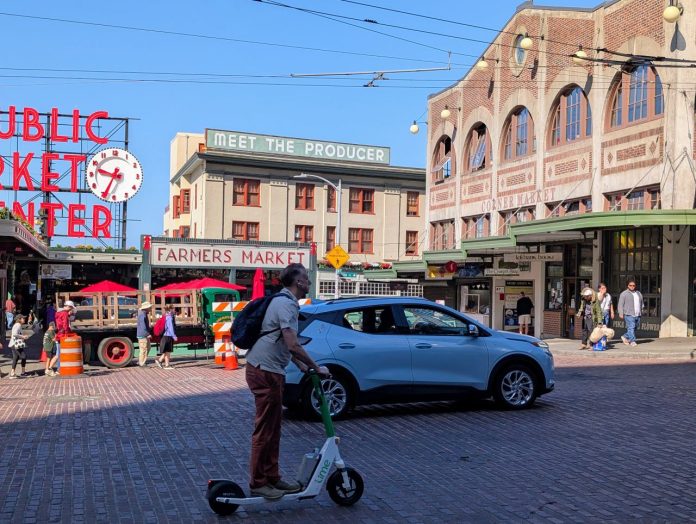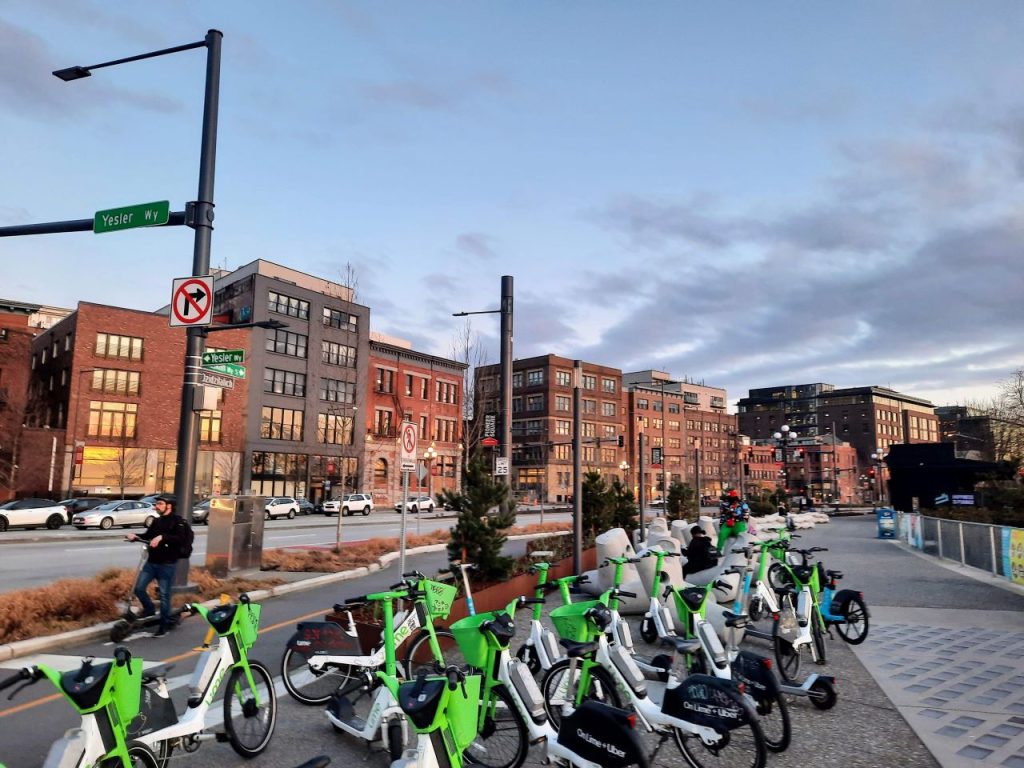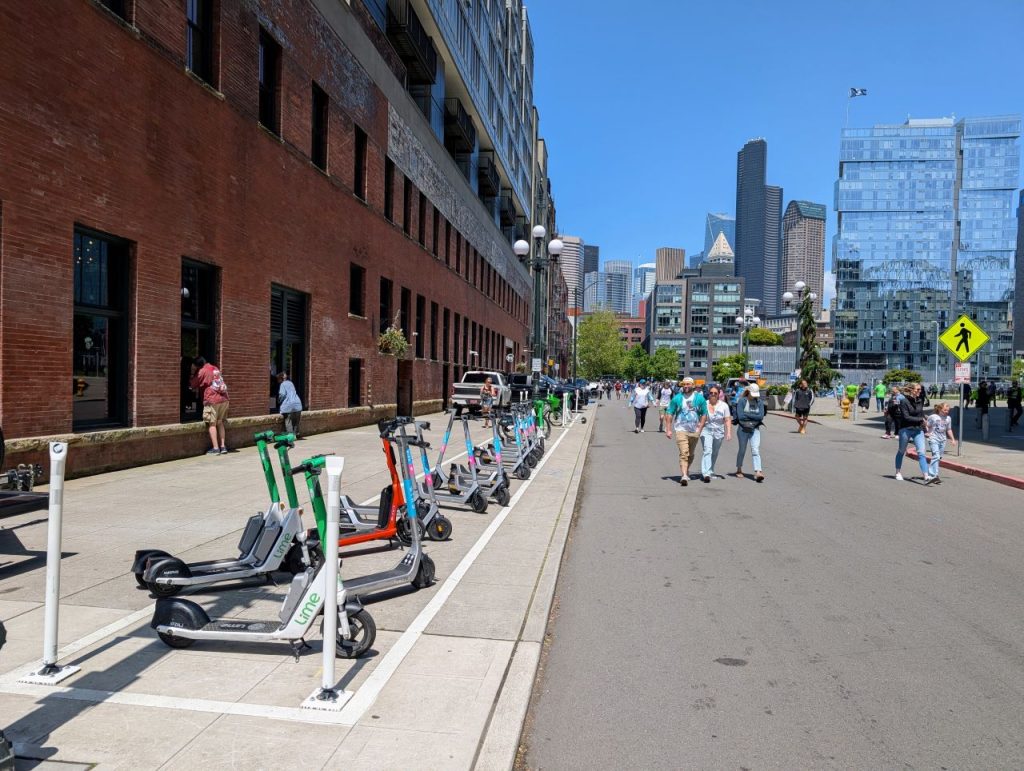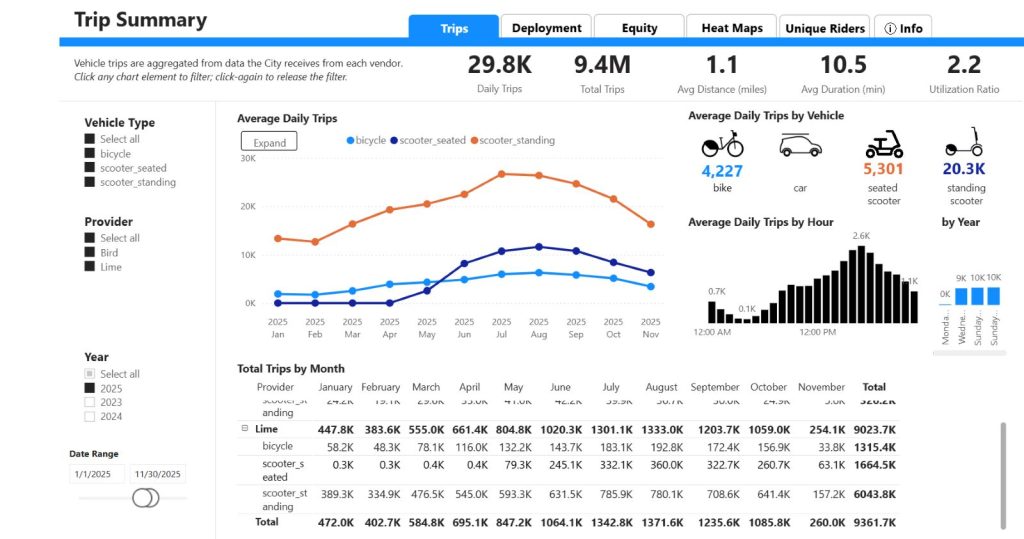
Seattle’s scootershare and bikeshare program continues to boom, setting a new ridership record in 2025. At the same time, the “micromobility” program could be at risk of falling victim to its own popularity, with increasing calls to beef up regulations, particularly on where scooter are able to be parked and ridden.
In fact, a recent op-ed in the Seattle Times by local author Steve Olson even argued the City should ban shared stand-up scooters altogether. It may sound extreme, but a few cities have gone down this route, including Paris, which approved a ban on scooters following a low-turnout 2023 referendum that indicated significant opposition among Parisians.
Of course, Olsen fell into many of the tropes of those opposed to scooters and bikes — blaming them for a spike in traffic deaths, and failing to identify cars as the deadliest force on the road.
“According to SDOT’s Vision Zero Action Plan, ‘the only acceptable number of serious injuries and lives lost on our streets is zero.’ Yet the city continues to allow scooter programs that are causing — and will continue to cause — widespread and devastating injuries as well as loss of life,” Olson wrote.
It’s a sentence where “scooter programs” could easily be replaced with “cars” — or “cars without speed limiting devices” for a slightly more moderate position. Seattle had 43 traffic deaths in 2024, and the vast majority not involve a scooter, but rather involved a motorist in a car. So far in 2025, motorists have struck and killed 15 pedestrians.
That is not to say that scooters aren’t dangerous. Axios recently reported that serious scooter injuries are on the rise, both nationally and locally in Seattle. The number of people admitted to Harborview Medical Center with injuries from e-scooter and e-bike crashes has increased every year since 2020, UW Medicine spokesperson Susan Gregg told Axios, adding that there were 29 such admissions in 2020 and 163 in 2024.
The high center of gravity when people are riding a scooter can make them especially prone to face planting when encountering a curb or pothole. These type of crashes can lead to ER visits, but statistics often lump scooter crashes together whether or not a motorist played a starring role.
Showdown at the parking corral
Seeking to address concerns about sidewalk clutter, the Seattle Department of Transportation (SDOT) is planning to build more parking corrals for micromobility devices — the collective terms for shared vehicles, whether bike or standing scooters or seated scooters. Lime has encouraged the City to expand corrals at a faster pace and has ramped up education efforts about not riding in the sidewalk (including in a recent advertisement in The Urbanist).

Hayden Harvey, Lime’s Senior Manager of Government Relations in the PNW, said current plans do not provide enough corrals to meet demand.
“237 [parking corrals] is what SDOT sort of has built into their plan today,” Harvey said. “Our analysis is that something more on the magnitude of like 800 are needed in the highest utilization areas of the city, meaning the downtown core, the U District, small portions of Ballard and Fremont.”
Lime backed a city budget amendment from Councilmember Rob Saka, who chairs the transportation committee, which would have allocated $200,000 to accelerate the pace of corral deployment. That amendment was rejected on Friday, but SDOT is still set to spend $675,000 in 2026 to add corrals. The topic is likely to return; councilmembers included a statement of legislative intent asking for a report on corrals.

Without a dense network of parking corrals, the free-floating model is likely to continue. But, adding corrals at scale would open up the possibility of a hybrid model, requiring corral parking in Seattle’s busiest areas for micromobility vehicles.
“The cities that have done this at scale have been able to shift from what you experience today as free-floating parking within certain geographic areas where crowd density is high enough to move to a mandatory parking scheme, where the rider can’t just end their ride wherever they we have various technologies and app that sort of you can only end your ride at the pin,” Harvey said. “This is common in Paris. But what’s fundamental to this type of shift from free floating to like a hybridized mandatory parking scheme is the corral density.”
Safe streets advocates have also made the case that building out a more robust network of protected bike lanes and multimodal trails is a key ingredient to solving safety concerns and addressing sidewalk congestion and clutter. The question of people riding scooters recklessly on sidewalks recently came up during the Life After Cars book tour, which came to Seattle on November 5. Co-author Doug Gordon, who co-hosts the War on Cars podcast along with journalist and co-author Sarah Goodyear, argued more bike lanes and pedestrian streets was the fix.
“The answer is just more space,” Gordon said. “You know? I really think that it comes down to like, that person was on the sidewalk because the street probably didn’t feel that safe, and so we need to take a car lane, if possible, and make that street safer.”
Booming scooter ridership
In April, The Urbanist reported on the upward trend in scootershare ridership: “Across three companies, Seattleites clocked 6.3 million rides in 2024, a new record high, up 28% over 2023. The momentum has continued in the first quarter of 2025, with ridership up 76% over the first quarter of 2024. If this pace is maintained, Seattle would exceed 10 million rides in 2025.”
While Seattle has not crossed the 10 million rides yet, ridership has surpassed 9.3 million with nearly two months still to go. This suggests the city is still on course for 10 million before year’s end, with an average of about 30,000 daily trips.

Lime continues to be the most popular operator in the city; the company just surpassed 9 million rides this year. This spring, Lime launched a new vehicle type: a seated scooter, which has quickly leapfrogged electric bikes in garnering ridership. Standing scooters continue to lead the way, accounting for about three-fifths of ridership, while e-bikes and seated scooters provide the other two-fifths.
The only competition is coming from Bird, which has clocked 330,000 rides through the first 10 months of 2025. Most of those riders are on scooters, through Bird also reports a trickle of bikeshare rides.

Scooter trips are heavily concentrated downtown and in a few surrounding neighborhoods, along with the University District, although a few smaller hot spots are scattered around the city. Some ridership spikes are event-based, but the daily baseline appears fairly high regardless of conditions.
“The weather was pretty terrible yesterday, and something like 14,000 people took tens of thousands of rides in the monsoon,” Harvey said. “So this is not a FIFA thing. This is not a Bumbershoot thing or any other large event. This is Seattleites using Lime every day to conduct the business of their lives as core transportation.”
Parker Dawson, Lime’s Senior Regional Lead for Government Relations, said that the shared micromobility program has provide a good complement to the transit network.
“In many ways, we’re a direct correlation to reducing traffic congestion,” Dawson told The Urbanist. “We’ve also got a direct correlation between our ridership and increased public transit ridership, which is a really great symbiotic relationship to be having in the transit network overall.”
It appears the main thing standing in the way of continued micromobilty growth is scaling up the infrastructure to match the ridership boom — in addition to avoiding a backlash that leads to dropping the regulatory hammer on providers.
While the Seattle Times opinion pages may give readers a different impression, Seattleites appear to have a favorable impression of scootershare and bikeshare, overall. Lime commissioned a poll of Seattle voters from EMC Research, which found widespread support for the program and for expanding parking corrals.

“Two-thirds of Seattle voters think the overall impact of shared electric bike and electric scooter services is positive – despite the fact that most Seattle voters are not regular micromobility users,” a poll memo stated. “Seattle voters overwhelmingly support (82%) building dedicated e-bike/e-scooter parking corrals in higher use areas of the city.”
While most Seattle voters are likely not regular micromobility users, many have dabbled. Lime data shows more than 340,000 unique users have taken rides in Seattle.
Author’s note: Lime buys advertising space from The Urbanist, but does not have a role in dictating editorial coverage.
Doug Trumm is publisher of The Urbanist. An Urbanist writer since 2015, he dreams of pedestrian streets, bus lanes, and a mass-timber building spree to end our housing crisis. He graduated from the Evans School of Public Policy and Governance at the University of Washington in 2019. He lives in Seattle's Fremont neighborhood and loves to explore the city by foot and by bike.



